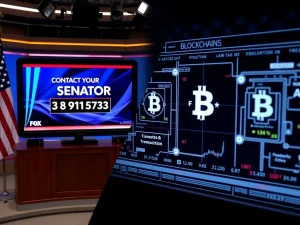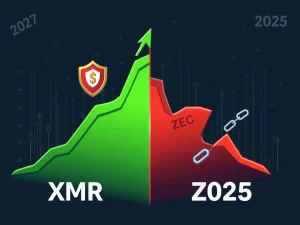Bitcoin Holdings: US Government’s Unwavering Stance Debunks $20B Liquidation Fears

The cryptocurrency world was recently abuzz with alarming whispers: the U.S. government was reportedly liquidating a massive $20 billion worth of Bitcoin. Such a move, if true, could send shockwaves through the market. However, leading blockchain analytics firm Arkham Intelligence has stepped forward to set the record straight, confirming that the U.S. government Bitcoin holdings of approximately 198,000 BTC remain stable and untouched since April 2025. This definitive clarification effectively debunks the widespread liquidation rumors, offering a crucial sense of calm to investors and reinforcing confidence in the market’s resilience.
Unpacking the Truth: US Government Bitcoin Holdings Remain Firm
For weeks, unverified claims of a 170,000 BTC sale by the U.S. government circulated across social media and online forums, creating unnecessary market jitters. However, Arkham Intelligence, a reputable blockchain analytics firm, has provided clear evidence to the contrary. Their meticulous analysis of public transaction records and official agency statements confirms that there have been no large-scale sales or transfers of government-held Bitcoin since at least April 2025.
- Total Holdings Confirmed: The U.S. government’s total Bitcoin stash stands at approximately 198,000 BTC.
- Clarifying Misconceptions: The confusion largely stemmed from a Freedom of Information Act (FOIA) request that highlighted the U.S. Marshals Service’s (USMS) specific holding of 28,988.356 BTC. This isolated figure was mistakenly interpreted as the entirety of the government’s Bitcoin, leading to misinformed speculation about a larger sale.
- Multi-Agency Assets: Arkham Intelligence clarified that the 198,000 BTC figure encompasses assets held across multiple agencies, including the FBI, IRS, and DEA, all managed under a consistent strategy.
Independent journalist L0la L33tz aptly noted that “the reported USMS holdings only represent a fraction of the total Bitcoin held by the U.S. government, leading to widespread confusion.” This distinction is vital for understanding the true scope of the government’s digital asset strategy.
Debunking the $20 Billion Bitcoin Liquidation Rumors
The recent wave of Bitcoin liquidation rumors, though quickly refuted, highlighted the market’s sensitivity to misinformation. These unverified claims, amplified by the echo chambers of social media, initially triggered short-term market volatility. However, their impact on broader cryptocurrency markets, including Ethereum or various altcoins, was minimal and fleeting.
Analysts consistently emphasize that the government’s established approach to managing seized assets—prioritizing transparency and structured auctions—is designed precisely to mitigate potential disruptions to Bitcoin’s liquidity. This proactive strategy helps prevent sudden price shocks that might otherwise occur from large, unexpected sales.
It’s a testament to the market’s growing maturity that such significant rumors, while causing temporary ripples, failed to trigger a broader downturn. This resilience underscores a deeper institutional confidence and a more robust market infrastructure capable of absorbing and verifying information.
On-Chain Data Confirms No Major Sell-Offs
The most compelling evidence against the liquidation rumors comes directly from the blockchain itself. On-chain data from July 2025 unequivocally confirmed no sell-off activity from known government wallets, perfectly aligning with Arkham’s comprehensive analysis of wallet transactions. This real-time, verifiable data provides an undeniable counter-narrative to the speculative claims.
Arkham Intelligence CEO Miguel Morel stressed the critical need for rigorous analysis to prevent misinformation from spilling into market decisions. He highlighted that the impressive $23.5 billion value of the 198,000 BTC holdings—calculated using July 2025 pricing—remains entirely intact, a clear sign of no recent major disposals.
The firm also issued a stern warning against “misleading headlines or fabricated wallet activity” that can intentionally or unintentionally distort market perceptions. Coincu’s research team independently echoed these findings, further solidifying the consensus that while structured auctions may create temporary ripples, the current market environment remains remarkably resilient.
Ensuring Crypto Market Stability Through Strategic Management
The U.S. government’s consistent inactivity regarding its Bitcoin holdings since April 2025 underscores its clear preference for controlled auctions rather than abrupt sales. This structured approach is a cornerstone of ensuring crypto market stability, preventing the kind of sudden supply shocks that could destabilize prices.
Historical precedents strongly support this strategy. Past sales of seized Bitcoin, notably those from the infamous Silk Road case, were conducted through public notifications and well-advertised auctions. These sales, despite their significant size, were absorbed by a diverse pool of buyers without altering Bitcoin’s broader trajectory or causing prolonged price declines. This track record reinforces the market’s capacity to handle large asset transfers when managed transparently.
Bitcoin’s price, which traded at $118,474.36 on July 24, 2025, has shown remarkable strength, rising 26.79% over 90 days. With a 60.86% market dominance and a $2.36 trillion market cap, its stability is largely attributed to growing institutional confidence and increasing regulatory clarity. While future announcements could influence short-term dynamics, the government’s current measured approach is a key stabilizing factor.
Understanding Government Bitcoin Auctions and Future Outlook
How does the U.S. government typically handle its seized Bitcoin? The established protocol involves public, structured government Bitcoin auctions. These events are announced well in advance, allowing potential buyers to prepare and ensuring a competitive bidding process. This method contrasts sharply with the idea of a sudden, covert liquidation that would catch the market off guard.
Market participants remain cautiously optimistic about potential future sales but widely acknowledge the current inactivity as a significant stabilizing factor. The U.S. government’s structured approach, combined with robust institutional adoption trends, strongly suggests continued liquidity without abrupt price shocks. As Bitcoin’s trajectory remains intricately tied to broader macroeconomic and regulatory developments, the focus shifts to how ongoing transparency in asset management will continue to shape investor sentiment.
Conclusion
The recent episode of $20 billion Bitcoin liquidation rumors serves as a powerful reminder of the importance of verifiable information in the volatile cryptocurrency landscape. Thanks to diligent analysis from firms like Arkham Intelligence, we now have clear confirmation: the U.S. government’s substantial Bitcoin holdings remain stable at 198,000 BTC, with no major sales since April 2025. This unwavering stance, combined with the government’s transparent and structured approach to asset management, plays a crucial role in maintaining crypto market stability. As the market continues to mature, relying on accurate on-chain data and credible sources becomes paramount for informed decision-making. Stay vigilant, stay informed, and always verify.
Frequently Asked Questions (FAQs)
1. What are the U.S. government’s total Bitcoin holdings?
According to blockchain analytics firm Arkham Intelligence, the U.S. government’s total Bitcoin holdings are approximately 198,000 BTC. This figure includes assets held by multiple agencies like the FBI, IRS, and DEA.
2. Were there actual rumors about a $20 billion Bitcoin liquidation?
Yes, widespread rumors circulated, amplified by social media, claiming the U.S. government was liquidating around 170,000 BTC, valued at approximately $20 billion. However, these rumors have been definitively debunked by on-chain data and official statements.
3. How did these liquidation rumors originate?
The confusion largely stemmed from a misinterpretation of a FOIA request that highlighted the U.S. Marshals Service’s (USMS) holdings of about 28,988 BTC. This specific figure was mistakenly generalized to represent the entire government’s stash, leading to unfounded speculation about a much larger sale.
4. What impact did the rumors have on the crypto market?
The rumors initially caused short-term market volatility for Bitcoin. However, due to the quick debunking by analytics firms and the underlying market resilience, there was no significant or lasting impact on broader cryptocurrency markets like Ethereum or altcoins.
5. How does the U.S. government typically sell seized Bitcoin?
The U.S. government employs a structured and transparent approach, typically conducting public auctions for seized Bitcoin. These sales are announced in advance, allowing for orderly market absorption and minimizing potential price shocks, as seen with past sales from cases like Silk Road.










